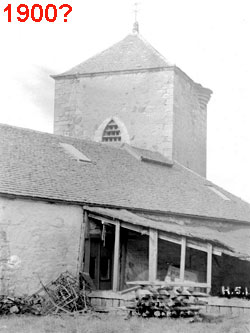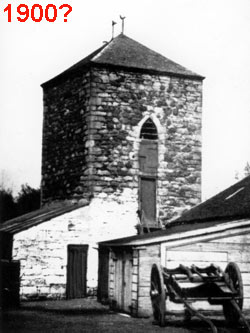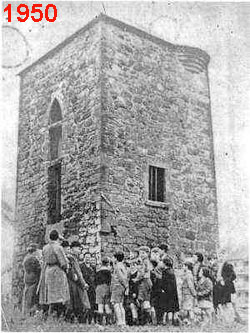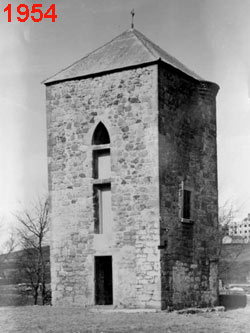|
Having read the article
on Thomas Crawford and in particular the following text:
“Thomas makes his way westwards,
following the old track that the Romans first made to Old
Kilpatrick. Just past Castle Hill he turns down the steep
road that winds through Peel Glen, over the narrow bridge
and up the hill towards the Peel Tower of Drumry.
His father built the tower house in 1530, in the year that
Thomas was born. It stands on high ground, so that a sentry
looking out from it can see the hamlet of Drumry and a vast
expanse of green fields and marshes beyond.”
More
on Thomas Crawford & the Peel Tower of Drumry
I felt I had to find out more having
formally lived on a housing estate in Clydebank called Drumry,
this being near a place known as Peel Glen Road and if you
head West you come to Old Kilpatrick. What follows is some
of the information, pictures and maps that I came across.
What these all point to is that both the tower and hamlet
of Drumry were approximately 1.5 miles to the East in what
is now Drumchapel, and the Peel Tower a renowned, though
sadly long since demolished, local landmark.
Firstly an artists impression of the
Peel Tower back in the 1500s

And how looked in the 20th century
before being demolished in 1958
Some history……….
From a Drumchapel
History Website
The Drumry Peel was built c.1535 by Laurence Crawford who
had obtained the land in an exchange with Sir James Hamilton,
himself attaining the land by marriage to Margaret Livingston.
Sir James acquired the lands of Crawfordjohn in the deal.
The Peel itself may have been a restoration or complete
reworking of a previous building used by the Livingston
family, the previous lairds. W.F. Hendrie's The history
of Livingston notes that the Livingston Peel was "By
1483, the tower from which de Leving defended his lands
stood on a rampart of ground and was surrounded by a thirty
foot moat, full of water." Their Drumry relatives may
have had similar defences, but originally the Peel would
have built from wood. W.F. Hendrie again: "... it is
believed that the word Peel comes from the French PIEUX
meaning wooden stakes which originally formed a high wooden
fence or pallisade...the Scots understandably, had difficulty
pronouncing 'pieux', called it 'peel' and even after the
wooden pallisade had gone retined the name Peel. The same
word gives rise to saying 'to be beyond the pale'."
The rebuilding of the Peel was a compliance with the 1535
Act of Parliament which demanded that each landowner was
obliged to build a barmkin, or small courtyard "for
the ressett and defens of him, his tennentis and their gudis,
in trublous tyme", with a tower within if needed as
residence. Inside this barmkin would have been stables and
other stores. The Peel had one room on each floor; the lower
floor would have been the hall, a removable stair leading
up to private quarters on the first.
The Colquhoun family acquired Drumry from the Craufurd family
in 1747. The Peel fell into disrepair but was restored and
renovated by Campbell Colquhoun in 1836
The tower was modified by Rev. J. Campbell Colquhoun around
1890; the upper part being used as a bothy for the farm
labourers and the lower as a stable. The surrounding farm
buildings that were around it at that time seem to have
been built with stones taken from the old St. Mary's chapel
and the Peel. One of the barns had a stone inscribed "Laurence
Craufurd". The smithy adjoining it was also built from
the Peel.
Drumry Peel, like Garscadden House, is noteworthy enough
to be mentioned in Cant and Lindsay's Old Glasgow of 1947,
though its Glasgow history only started in 1938 after Drumchapel's
annexation. They write "A fragment of a sixteenth century
castle has been incorporated, in the eighteenth century,
in a narrow tower with a pyramid roof. Drumry belonged to
the Livingstones, the last being killed at Flodden."
The Royal Comission of Ancient and Historical Monuments
writes "When seen in 1951, the remains consisted of
a tower 5.5m square, in good states of repair, used as a
store-room for Drumry farm." Despite local protestations,
the Peel was demolished in 1958 by Glasgow Corporation when
they claimed the building was derelict. The site of the
Peel is given as NS 5149 7106.
And from the Website of the Drumchapel
Heritage Group
A place of attraction to the rows was
a big building which stood in the stockyard of the farm
of North Drumry. Said to have been built after .1530-. The
design of the building lends itself to being an accurate
description. This historic buildinq was the Peel of Drumry.
For over four hundred years until 1956 on of the most famous
landmark in Drumchapel was the Peel of Drumry . This stone
building which was sixteen feet high, with walls two feet
thick stood in the stockyard of the farm of North Drumry,
(on a site between Abbotshall Avenue and Halgreen Avenue).
Apparently it had been built somewhere
between 1530 and 1540 by Laurence Crawford who's family
originally came from Ayrshire, but it is quite possible
that a similar building had stood on the same ground hundreds
of years earlier.
The tower was built as a vantage point so that from the
top one could see far distances from this drum or ridge
where perhaps some ancient king had built his fort. After
all, the place name of Drumry means ridge of the king.
The Livingston's, early landowners
of Drumry, in the late fourteenth and early fifteenth centuries,
before the Crawfords took possession of the land. It does
seem almost certain that the Peel which stood until 1956
was the work of Laurence Crawford, or, at any rate a restoration
by him of earlier work.
The tower had to be repaired twice in the nineteenth century,
once by the Rev. J. Campbell Colqohoun.
The latter fitted up the upper portion
of the tower as a bothy for the male servants employed on
the farm, while the ground floor was used as a stable. Mr.Veitch,
the last farmer at North Drumry, used the Tower to store
oats and thus the famous building had become a barn.
With the building of the housing estate
and the invasion of the "Townies" the Historical
monument came under threat of demolition. This despite pleas
and offers of cash aid by the director of Museums and Art
Galleries, the Glasgow Archaeological Society, The National
Trust for Scotland. The Ministry of Works and the Glasgow
Tree Lovers Society. The Housing committee of the Glasgow
Corporation had reached a decision which seemed immovable.
The Conservative M.P. also raised question in the House
of Commons for Scotstoun, Sir James Hutchison inviting the
Secretary of State to "Take steps to prevent the demolition
of this Historic building.
One of the main opponents to saving
the Peel, was Peter G. Forrester, Convener of Glasgow Corporation
Housing Committee, said," that to say that the Peel
of Drumry should be maintained is like saying that some
of Glasgow's ancient slums should be maintained for all
time". What a sad utterance.
So, despite offers of cash from various
bodies interested in saving the Peel, the housing committee
of the Glasgow Corporation upheld their decision on the
1st November 1956. Work on the demolition began on the 6th
November 1956 just five days later and was completed in
a very short time.
The original stones from the Peel of Drumry can still be
seen today as they form part of the rockery in the Garden
of Remembrance at the rear of St.Mary's Parish Church in
Drumry Road.
Maps
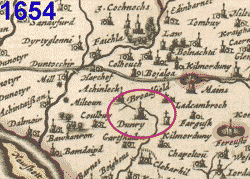
|



